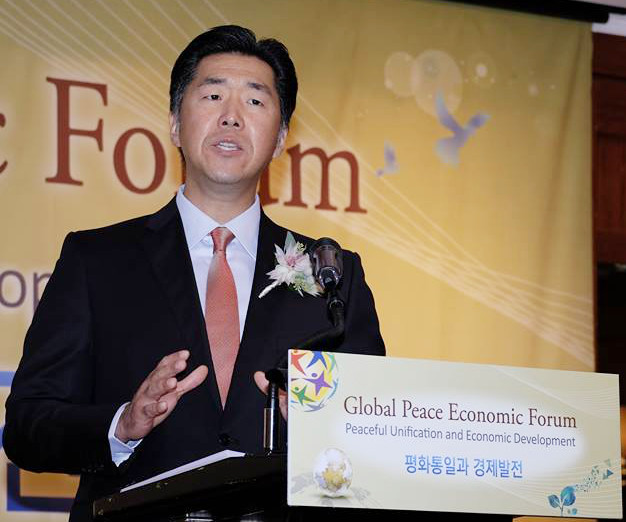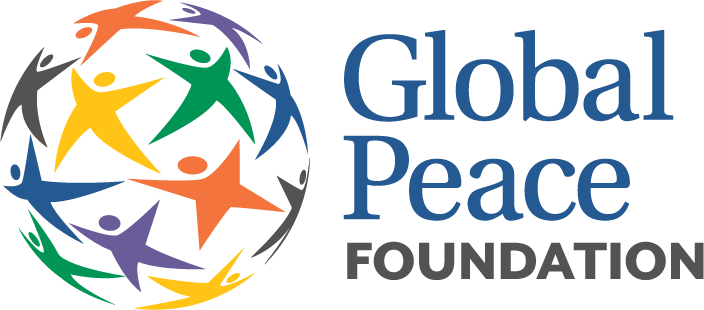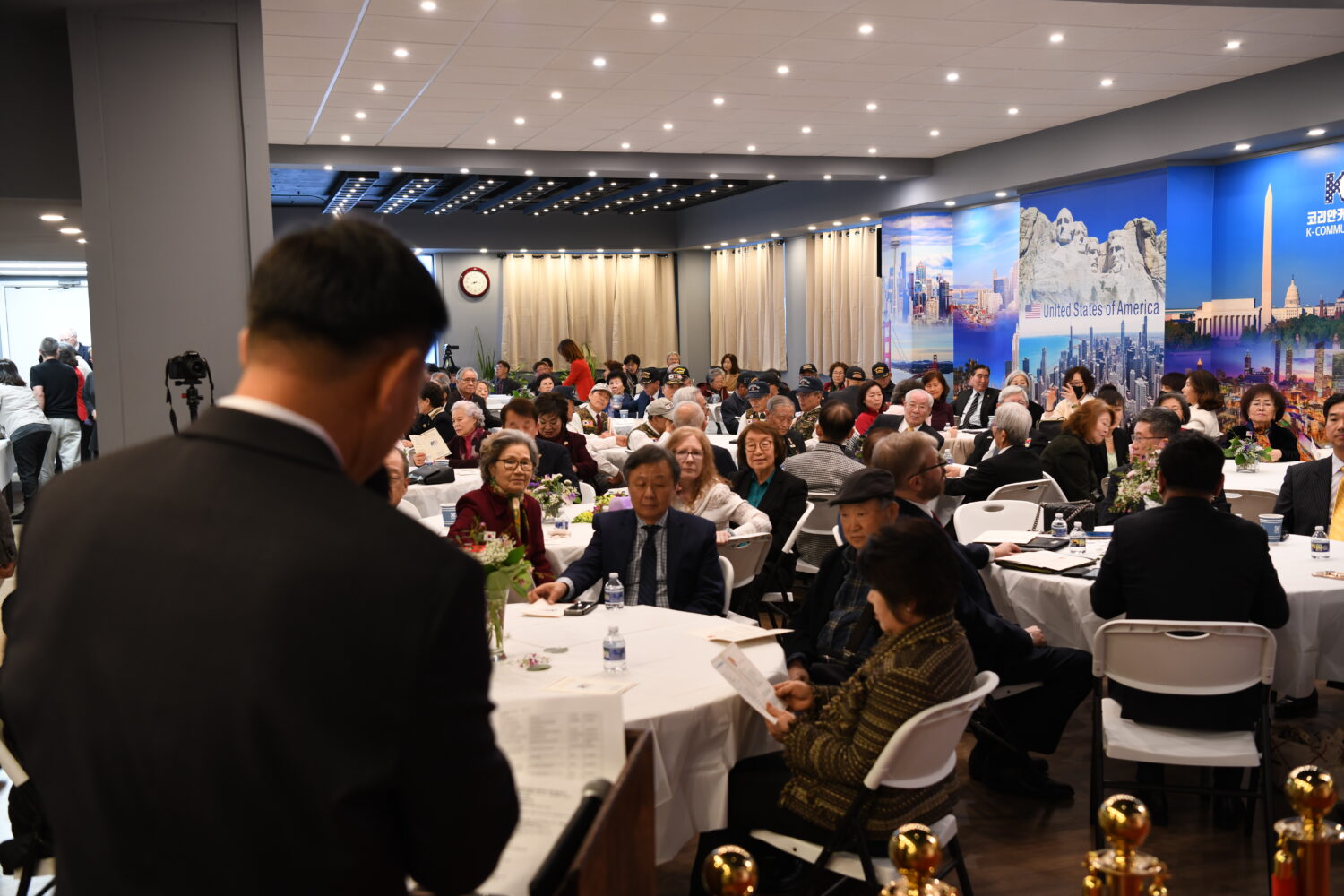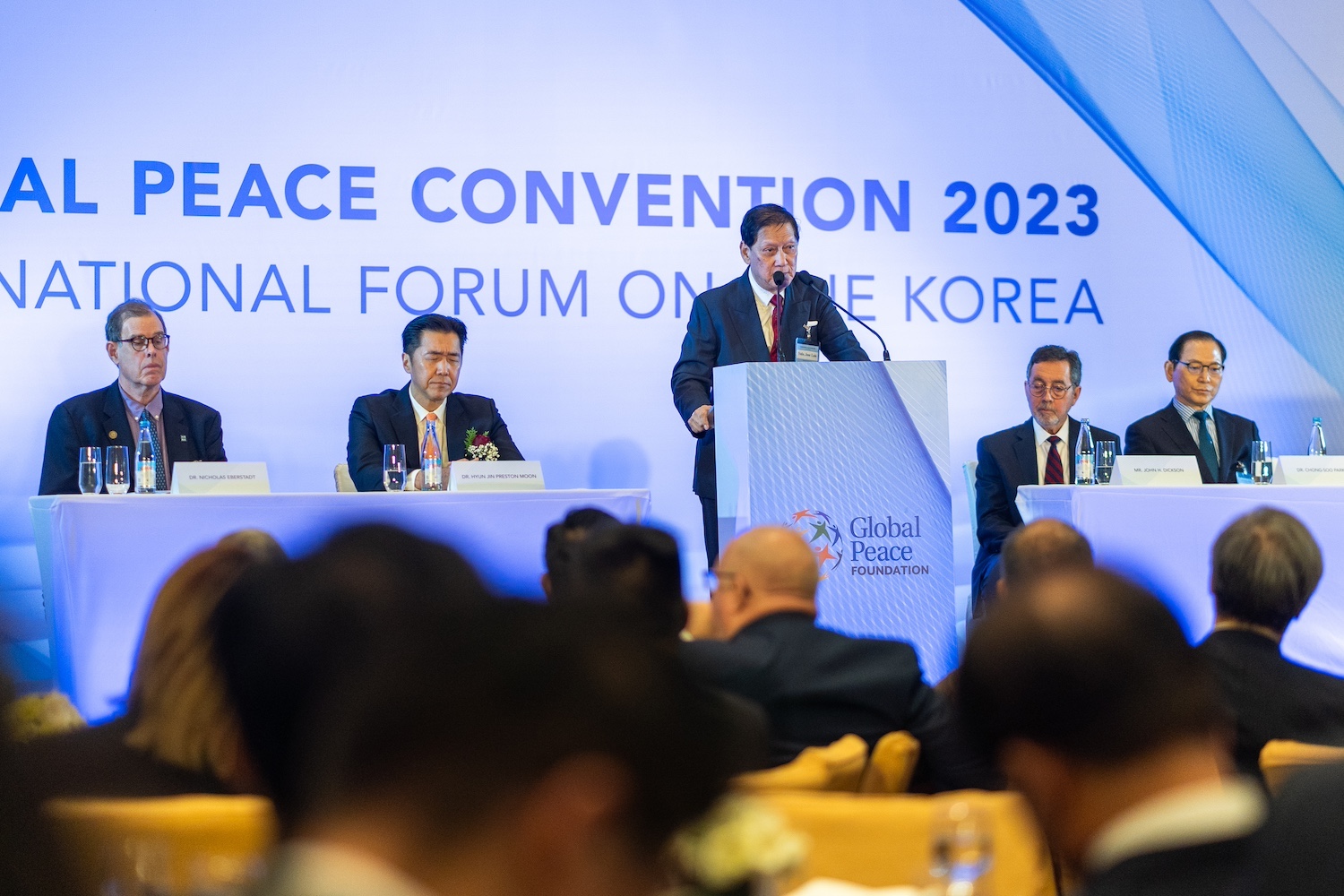“Peaceful Unification and Economic Development”
October 8, 2015
For the speech in Korean, visit here.

Dr. Hyun Jin Moon calls for economic reforms in the Republic of Korea supporive of Korean unification.
Distinguished guests, ladies and gentlemen:
It is a great honor and privilege for me to be hosting the first international Global Peace Economic Forum here in Seoul, on the heels of the historic 70th anniversary of Korea’s liberation from Japanese occupation. This is a momentous time for the Korean people. It is a moment of inflection where tremendous change could come and whether that change be good or bad is dependent upon what we do today. In this regard, I would like to thank all of you for your participation and your leadership in shaping the future of this land, this region, Asia and the world.
I would like to give special thanks to the Honorable Kim Jin Pyo, Former Deputy Prime Minister of Strategy and Finance, the Honorable Park Dae Dong, Member of the National Assembly, and Dr. Kim Joohyun, Head of Sub-committee of Economy with Presidential Committee for Unification Preparation, for helping to organize this forum.
I would also like to acknowledge our illustrious foreign dignitaries President Vinicio Cerezo and Prime Minister Raila Odinga for joining us here today as well as the countless other guests from abroad that are committed to the work for peace and the welfare of the Korean people. You have our eternal thanks and gratitude.
Let us give all of them a warm round of applause.
Advancing Toward Reunification
As I have mentioned, we are gathered at a special moment in the history of the Korean people. Although the peninsula is still divided, new winds of change are sweeping this land and the region, making the promise of reunification ever more real. The recent trips of President Park Geun-hye to China, where she was warmly received by President Xi Jinping, together with her September 28th address to the UN General Assembly suggest the changing geopolitical relationships in the region. It suggests a growing international consensus that South Korea should lead the issue of peaceful reunification.
The old Cold War line-up is fast dissolving. Of the North’s historic backers, the Soviet Union is no longer in existence, and China is rethinking its policies toward the peninsula. I outline these changes in the 3rd chapter of my book the Korean Dream: A vision for a United Korea, published in the fall of last year. There, I give a new prescription for reunification by going beyond the old Cold War paradigm that have governed regional relations over the past three decades and shaped the Six Party talks.
Paramount to this new thinking is the focus on the “outcome” of reunification rather than the “incremental processes” to unite the peninsula without a clear consensus as to what a reunified future might bring. In addition to this new framework, I emphasize the importance of engaging the Korean people in driving this issue forward, with the support of the international community; instead of it being driven exclusively by the two governments in the North and South. This bottom-up approach necessitates the articulation of Korea’s historic identity and destiny in line with the Hongik Ingan ideal and, in so doing, reminds all Koreans that the last seven decades is but a moment in the long arc of our history which has spanned five millennia.
I learned first-hand the failures of the Sunshine Policy more than two decades ago when my father, the Reverend Dr. Sun Myung Moon, became the first person to open the door to the North. What followed was more a failure of the South than the duplicity of the Kim regime. All manner of South Korean entities made a “mad dash” to the North without any coherent over-arching strategy, and often at cross-purposes with each other. This lack of vision and clarity about the outcomes of engagement allowed the Kim regime to survive and, later, fund its nuclear program.
Today, however, things have changed dramatically. We have the lessons of the past, changing geopolitical dynamics and, more importantly, through the efforts of those engaged in this conference, a growing consensus in the South around the vision I outlined in my book. Under the banner of Action for Korea United and the One Dream One Korea campaign, we have gathered all of Korea’s representative religions, over 700 civic organizations with more joining by the day, representatives from both political parties and, with the new reunification song campaign, a growing number of student and youth groups throughout the South.
For the first time since 1945, a new movement for reunification united around a singular vision, the Korean Dream, is gaining momentum in the South and spreading its appeal to the diaspora communities in Japan, the United States, China and Russia as well as other parts of the world. For the 70th anniversary of independence, festivals and conferences were held in these nations with key local partners to celebrate Korean solidarity on reunification. This momentum will crescendo with tomorrow’s event in the World Cup Stadium in front of more than 50,000 young people and televised nationally on SBS. This movement carries the spirit of the independence movement of the last century with the promise of opening a new chapter of Korean leadership in this one.
For the first time since 1945, a new movement for reunification united around a singular vision, the Korean Dream, is gaining momentum in the South and spreading its appeal to the diaspora communities in Japan, the United States, China and Russia as well as other parts of the world.
For me, the reunification and subsequent creation of a new nation has always been a lifelong aspiration that has run throughout my family. My great-granduncle had been an activist for Korean independence and one of the drafters of the Korean Declaration of Independence during the March protests of 1919. My father later carried the torch with his historic trip in 1991 to the North, opening relations between the two Koreas, in addition to his various business and peace initiatives on the peninsula.
It is within this context that I would like to address the theme of building the 21st century economic model for the reunified Korea.
Need for Economic Reform
As momentum builds for the creation of a new reunified nation, it is crucial that the South prepares itself to lead the greatest merger in human history up until this point. German reunification will pale in contrast to the opportunities and challenges afforded by Korean reunification. First, it will offset the intrinsic macro-economic problems of both economies as the two parts of Korea have exactly what the other needs for sustainable growth, although integration of the opposing political, social and economic systems will not be easy. Secondly, it will end the security issue on the peninsula and in the region, especially the nuclear threat and risk of proliferation that will be the stimulus for regional growth and prosperity with global implications.
That is why it is absolutely critical to make sure the health of the South Korean economy can support integration. The South’s institutions, from the government to the business sector, need to honestly assess whether they have the experience, capability and capacity of leading the reunification process. Successful economic integration will be the most important component of reunification since it will support all the other initiatives in integrating the political and social life of the two Koreas. As a result, old methods and outdated paradigms must give way to more dynamic models that are forward-looking and growth-oriented.
South Korea’s meteoric rise over the last 70 years was fueled by the growth of chaebols and the government policies that supported them. This had its place during the 1970s and 80s when, as an emerging economy, the South needed to build scale in key strategic industries. Yet, in today’s mature domestic market, that same structure is no longer a benefit as it is unable to generate enough jobs, allow innovation and flexibility, or to fuel growth. Most importantly, it stifles competition which is the engine of a dynamic economy. This sad reality is reflected in the under-valued price of Korean assets in global capital markets.
As such, economic reform is critically needed. Otherwise, the outdated economic structures of the South will face tremendous challenges in trying to support the reunification process. The time to rethink an effective economic strategy with its structural implications is now, well before reunification.
As momentum builds for the creation of a new reunified nation, it is crucial that the South prepares itself to lead the greatest merger in human history up until this point.
Current Systemic Deficiencies
Much needs to be done. Despite many successes and accomplishments to-date, South Korea is still plagued with problems that are preventing its economy from unlocking its full potential. The significant unemployment rate of those in their 20s to 30s is a case in point. Korea’s greatest asset is its well-educated and hardworking people. While the South boasts one of the highest education standards of all developed countries, it also has one of the highest unemployment rates in this age group, at over 10%, its highest since 1999.
This is even more troubling when one juxtaposes this reality to the shrinking youth demographic in the South. Even with this shrinking labor pool, South Korean business lacks the capacity to provide the jobs and opportunities that many capable young people need. I believe this is directly attributable to the “crony capitalism” that gave rise to the chaebols and, then, the subsequent rise of a countervailing militant organized labor movement. The result has been an environment in which new capital creation is next to impossible.
In general, the economic landscape needs to provide a level playing field with simpler laws, fewer regulations and easier access to capital for everyone and not just the privileged few. Engaging more Koreans in “capital creation” will stimulate the South’s economic engine far beyond current levels and create the necessary jobs and opportunities not only for the South but also the North. Economic reforms to unleash the South’s true potential should be made a national priority, as a prerequisite for advancing the issue of reunification between the two governments. This is a problem that the South can and must fix if it is to be healthy enough to lead the reunification process.
Reforming the Korean Economy: Liberalization of Financial Markets
Today, a handful of chaebols dominate the South’s economic landscape. Ironically, the IMF legacy, from the turn of the century, has centralized the control of the nation’s economy into the hands of fewer chaebols than pre-IMF levels. I am sure this was not envisioned by the government and business leaders of the 70s and 80s that implemented the current system.
Accounting for nearly all of Korean GDP today, chaebols dominate all facets of economic life, hoarding profits and squeezing suppliers while stifling the growth of smaller businesses that employ 90% of the labor market. Consumers are shortchanged by the lack of competition which, naturally, lead to price manipulation and the corruption that follows any excessive consolidation of power. Most of all, the nation suffers as it is held hostage to the whims of a small elite group of chaebol families, suppressing opportunity, innovation, entrepreneurialism and eventually hindering economic growth. Growing negative sentiment toward the chaebols and their archaic legacy speaks volumes to the reality that the status quo is unacceptable.
This sentiment has a harmful effect on all other stakeholders in the economy as it leads to an anti-business environment at large. In this landscape, the chaebols do fine since they control the economy and the political class. Yet, it creates “huge barriers to entry” for any smaller player or entrepreneur since they lack the resources and connections to navigate the treacherous labor market and regulatory terrain as well as a bloated and corrupt government bureaucracy in the pockets of the chaebols. In other words, it makes it next to impossible for the average citizen to have the opportunity to participate in the economy as a capital creator instead of a cog in the established chaebol pipeline.
For someone like me, who grew up in the United States, this is anathema to the ideals of the free market and capitalism. The goal of government should be to ensure that there truly is a “level playing field” for all its citizens. Its policies should provide opportunity for everyone and not an elite few. Beyond that, it should not involve itself in the markets.
In general, the economic landscape needs to provide a level playing field with simpler laws, fewer regulations and easier access to capital for everyone and not just the privileged few.
In order to address these problems, we need to envision a new economic paradigm. Strangely, despite the end of the military dictatorship and the beginning of democratization, the South’s economy has remained trapped in its old structures, even while political life has undergone major change. Liberalization of the political system should be followed by liberal reforms in the economy to ensure opportunity for all Koreans. With a new mindset we should seek solutions that can unlock the potential of the Korean people and free them to be doing what they naturally excel at; that is, innovate, take risk, explore uncharted opportunities, and work hard to become successful.
I believe the most effective and critical path toward that paradigm is to challenge and reform the current systemic limitations in the financial industry and the related government regulatory systems. In principle, when capital is allowed to flow, unhindered by unnecessary regulation or policy, into economic opportunities, great things begin to happen. Free markets governed by the laws of supply and demand, naturally fill any need, like the balancing of high and low pressure systems in the atmosphere. It is the most efficient way of dispersing the necessary capital for the needed opportunity, leading to greater capital creation.
That is why Korean financial institutions, with the support of government policies, should not merely sit on their excess cash but should deploy a greater portion of their capital toward financing new growth and opportunity, thereby making their money work harder for all its stakeholders. In doing so, they would be investing in the future of the Korean economy as well as helping to liberalize it so that the brightest and most talented could achieve their dreams outside the chaebol pipeline; thus breaking the monopoly hold of the chaebols in the Korean economy.
With easier access to capital, just imagine how many new start-ups there could be in the South. This will lead to reforms in the financial sector that will subsequently stimulate its expansion with the growth of private equity and investment banking outside traditional banking structures. This, in turn, will stimulate all other industries, especially the technology sector. The greatest challenge for start-ups is capital. But with new access to funding, who will be the next Naver, Daum Kakao, or Coupang? The sky is the limit.
In addition to stimulating technological innovation, it will create greater market discipline in the traditional industrial sectors. Inefficiently run companies will be natural targets for mergers, LBOs and acquisitions as easier capital accumulation will allow those disciplinary pressures to be felt, as was the case in the Western democracies. This should lead to greater transparency, governance, and efficiency in the markets to the benefit of the shareholders, the Korean people and the nation.
Similarly, South Korean financial institutions should leverage these reforms to proactively seek growth opportunities internationally. First to secure new markets, raw materials and investments and, secondly, to establish global leadership. Korea is already a mature market, and the data clearly shows that the Korean economy is battling low growth and low inflation. Korea’s long term viability and growth hinge on the financial sector facilitating growth abroad which, in turn, will tie those markets to Korea.
However, Korean financial institutions today remain notoriously bureaucratic, inefficient and risk-averse, unable to function effectively in connecting capital with opportunities, both domestically and abroad. In comparison, while not perfect, their U.S. and European counterparts undeniably excel at capitalizing on unique growth opportunities. They always look beyond the current markets and situations from which they safely operate, and constantly seek the necessary tools to bridge existing limitations or restrictions. This predisposition to pioneer, while managing risk, leads to win-win outcomes for all stakeholders, as the pie grows and values are maximized.
Case Study: Paraguay
As an example of Korean financial institutions’ general reluctance and inability to pursue well-managed growth opportunity, I would like to cite the Paraguay case in particular.
In the early 2000s, Paraguay was an environment of major political and economic uncertainty, making it a textbook example of a place unfit for foreign investment. However, beginning with my work there in 2008 together with the Global Peace Foundation, we have taken deliberate and strategic steps to manage various political and social risk factors, whereby the nation has undergone a significant transformation, and has now become an attractive yet untapped market that is primed for substantial returns.
In 2008, I personally debated with the then-President Nicanor Duarte, for almost two hours, arguing that it was ill-advised for him to expropriate foreign-owned assets for short term political gains. I urged him and the subsequent Paraguayan leadership that they must uphold fundamental universal principles of individual rights to freedom and property, and that the rule of the law must be respected by everyone, for the nation to attract foreign direct investments.
The experience that Korean institutions gain in investing in Paraguay can be directly transferred to the process of integrating the North when reunification comes.
We formed a think tank to promote stability and a long-term view of governance guided by principles-based policies. This approach stands in contrast to many Latin American nations that have created policies around personalities and regimes. Our institute now serves as the most respected and influential voice in Paraguay and works in partnership with institutions such as the Heritage Foundation to help Paraguay progress even further.
In the end, we have effectively mitigated what many would call “country risk,” through my various social programs and conferences on good governance. Moreover, we have planted a vision for Paraguay as the gateway and hub for Latin America, much like Switzerland, Singapore or Dubai, where it becomes the center of diverse distribution, industrial, financial and legal services for the region. With its strategic location, abundant natural resources, low energy costs, low tax rates, favorable investment laws, stable political institutions and a young labor pool, Paraguay has become a hidden gem.
It is important to note that the real appeal of Paraguay for Korea is not economic alone but, as I mention in my book, the opportunity to engage directly in the development of a third world economy that was once considered the “basket case” of Latin America. The experience that Korean institutions gain in investing in Paraguay can be directly transferred to the process of integrating the North when reunification comes. This type of real world experience will prepare the South beyond current levels and greatly contribute to a smooth transition of building a reunified nation.
Many of the challenges from the German experience came from the unanticipated collapse of the Eastern regime and the West’s lack of preparation to deal with real contingencies of reunification when it suddenly occurred. Korean reunification, however, can be managed and controlled by building the direct experience and best practices of nation building learned in Paraguay’s development. This is where the real advantage of Paraguayan investment lie.
Reforming Government Policies and Regulations
Yet, I have hit a wall when speaking with the heads of Korean financial institutions about the exciting opportunities in Paraguay. They lay responsibility on the South Korean government’s policy for their inability to take action. In stark contrast to the smart monies from Europe, Latin America, and even China that are moving into Paraguay, Korean financial institutions seem incapable of overcoming their current limitations. Systemic problems as well as the bureaucratic mindset that plague all government institutions have prevented them from taking bold, innovative steps to capitalize on the obvious opportunities, as they opt for safe mediocrity over value-maximization.
The Korean government needs to step in and support the financial institutions to make their capital far more competitive and global in reach. Government policies must be revised to remove barriers and constraints due to outdated models, to liberalize financial markets, and to incentivize investments that promote growth.
China, for example, is not sitting idle; its government-backed investment dollars are hard-at-work internationally, taking advantage of as many growth opportunities as they can handle. Our government should also follow suit and commit to substantially increasing foreign-directed investments, especially in the underdeveloped markets, and also to provide increased loan guarantees and insurance mechanisms to help bridge the gap between developing markets and Korean capital.
The creativity, drive and heart of our people are our greatest strength. We need to ensure that the culture and the systems of our nation will support the full potential of the Korean people now, and as a reunified nation in the near future.
Conclusion
Korea stands at a crossroads. Rooted in our founding aspiration, we have an opportunity to reinvent Korea based on the best models from the East and the West as well as the past and the present. As Korea moves toward reunification, this new 21st century paradigm for Korean economic development will allow the reunified Korea to unlock the latent potential of its greatest asset, the Korean people. The creativity, drive and heart of our people are our greatest strength. We need to ensure that the culture and the systems of our nation will support the full potential of the Korean people now, and as a reunified nation in the near future.
As the only nation still divided from the Cold War era, we need to ensure that this new nation is greater than the one we are currently living in, both in form and in substance. This will require our best efforts. However, with everyone joining hands, I have no doubt that the reunified Korea will truly stand as an inspiring global model for successful peace and development and play a leading role on the world’s stage for many years to come.
May God bless you and your families. Thank you very much.
For the speech in Korean, visit here.



